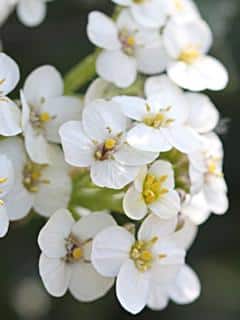

Sea kale, or Crambe maritima, comes as quite a surprise: both in the garden and in the vegetable patch, it’ll trigger questions by curious onlookers!
Botanical name – Crambe maritima
Common name – Sea kale
Family – Cruciferae, Brassicaceae
Type – perennial
Bearing – clump
Height – 12 to to 28 inches (30 to 70 cm)
Planting density – 4 to 6 plants per sq. yard (m²)
Exposure – full sun
Soil – any type, cool
Flowering – May to July
This plant’s name, sea kale, comes from the shape of its gray-green leaves. After all, they’re wavy and frizzled, just like those of regular kale. At the beginning of summer, cute and fragrant white flowers appear.
Whether you’re planning a flower bed or a vegetable patch, sea kale will for sure find a place in your garden. Even more so if you’re on the coast! Soil type has no influence on how your Crambe maritima will grow. In particular, salt in the soil isn’t even a problem. However, to truly thrive, Crambe requires:
For the planting, simply purchase young seedlings in stores and transplant them. Naturally, sowing is a great option as well. So as to start them off well, plant from March to June in seed holes 2 feet (60 cm) apart with 2 or 3 seeds per hole. After about a month, select the most vigorous sprout and thin the others away.

You can multiply your Crambe maritima in Spring by preparing root cuttings:
If you wish to eat your sea kale, here are a few important tips:
This means to keep them in the dark while still on the plant, so that they don’t see any sun at all (or only very little). With this in mind, just flip an empty pot over the center of the clump to cover the leaves. Every day, for one or two hours at dawn or dusk, remove the pot so that the plant can breathe. This also prevents molds.
Sea kale has a somewhat nutty taste. Unlike the oysterleaf herb which also grows near salt water bodies, it doesn’t taste as salty.
In order for your harvest to keep, place it in the refrigerator. It’s also possible to freeze leaves, but first you’ve got to blanch the leaves in boiling water. Blanching is a term used in cooking, too! It is a partial cooking that makes keeping easier.
Like most other Brassicaceae cabbages, Crambe is vulnerable to cabbage clubroot which is a fungal disease due to Plasmodiophora brassicae. Main symptoms are:
If you realize that a plant is infected, it must immediately be removed and eliminated. Furthermore, to fully eliminate the disease, brace in for the long haul since you have to wait seven years before planting any type of Brassica on that same plot. As for pests that may damage sea kale, you’ll likely encounter:
This double-purpose plant is ideal to decorate a garden, a terrace, and even a kitchen windowsill, since sea kale is also perfectly edible!